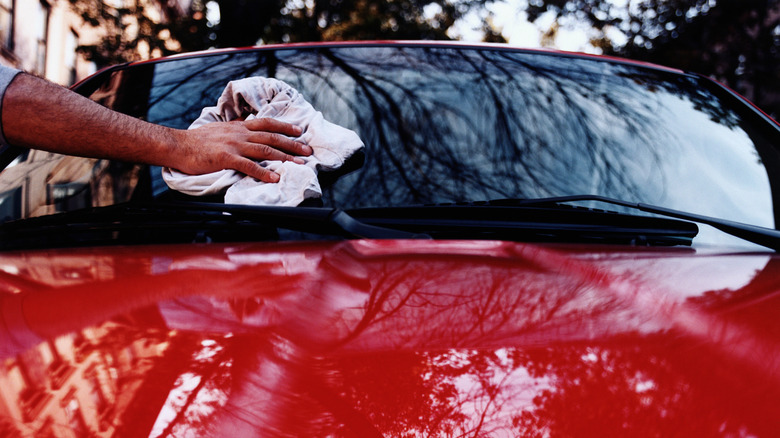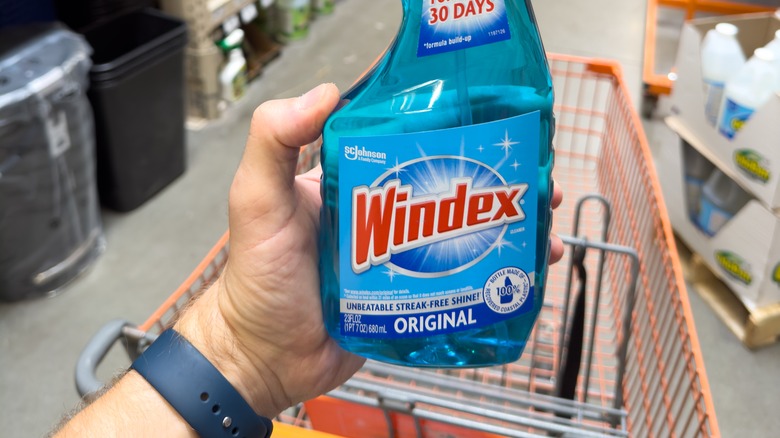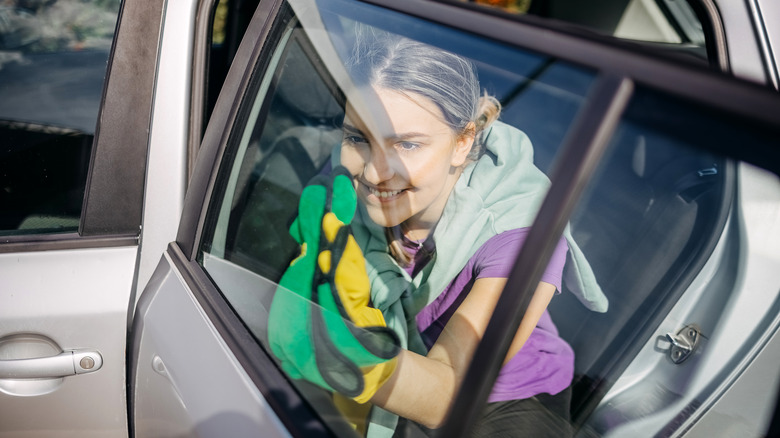Can You Use Windex On Your Car's Windows & Windshield? Here's What The Company Says
We may receive a commission on purchases made from links.
If there's one product to grab when you're fed up with your smudgy windows and dirty floors, it's probably Windex. This cleaning solution has been a household staple for years, and homeowners have found every unconventional use for it, from repelling and killing bugs to removing grease from your kitchen countertops.
But Windex isn't just useful around the home — it particularly comes in handy for cleaning your car as well. For instance, it's one of the best ways to restore your car's headlights. Just spray it on a microfiber towel and polish up the foggy cover. You can also use Windex, specifically the Electronic Cleaning Wipes, for cleaning your infotainment system.
However, you may be wondering: since Windex is originally a glass cleaner and your car has glass windows and a windshield, is it okay to use Windex on those too? The short answer is yes, but there's a catch — the classic blue formulation isn't actually the best choice for this task.
Is Windex safe for your car's windshield and windows?
Windex started off as a car windshield cleaner in the 1930s, so it's only natural to think it should work just fine for wiping down your vehicle's windows and windshield. However, cleaning automotive glass with the Windex Original Glass Cleaner (a.k.a. the blue version) would likely cause problems. That's because the blue formulation contains ammonium hydroxide, better known as ammonia. While this ingredient makes Windex a powerful cleaning spray, a Windex ammonia-based cleaner is one auto product that can do more harm than good for your car. Ammonia tends to strip away the tint layer on your tinted windshield and windows over time, so you'll be left with a patchy-looking glass and reduced privacy and UV protection. It can also make your windows streaky and foggy, potentially limiting your visibility. Most importantly, continuous use of ammonia can affect the frame holding the glass, and this is a safety hazard you'd definitely want to avoid.
But if the Windex Original Glass Cleaner isn't recommended, what should you go for instead? According to Windex itself, the Ammonia-Free Glass Cleaner (the light purple formulation) is safe to use on your automotive windows and windshield. It's also suitable for other car parts like your side and rearview mirrors, stainless steel and vinyl surfaces, and any plastic components. When using the Windex Ammonia-Free Glass Cleaner on tinted windows, though, make sure to do a test spot first. Apply a small amount somewhere inconspicuous to see if the solution works well with your kind of tint. Make sure not to let the spray drip onto the paint too.
Windex alternatives you can also try for your automotive glass
Apart from Windex Ammonia-Free Glass Cleaner, there are also a range of other effective auto glass cleaning sprays car owners recommend. Many swear by Invisible Glass Aerosol, which is ammonia-free and leaves no residue. Some suggest Sprayway Glass Cleaner. It also doesn't contain ammonia and is great at removing dirt and grease. The best way to use it, though, is to spray it directly on a microfiber towel instead of the window and keep it light — overdoing it would just produce streaks. Other glass cleaners you might want to check out are Adam's Brilliant Glaze and 3M Glass Cleaner.
If you want to save and go the DIY route, you can mix yourself a homemade auto glass cleaner with distilled vinegar and water. Simply combine equal parts of both liquids in a spray and clean your windows and windshield as you normally would. Just make sure to keep the solution away from your paint as the acidity might damage it. You can also use dish soap to wash your car, specifically the windows and windshield, but again, avoid getting it on your paint. Add a couple of drops of dishwashing liquid to a bucket of warm water and wash away. If you have baking soda at home, mixing a quarter cup with equal parts dish soap and a gallon of water should keep your windshield clean and streak-free.


